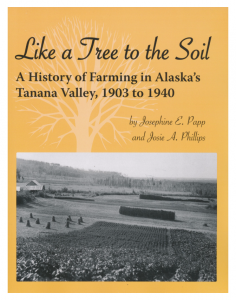Gardening seems to come as naturally to residents of Alaska’s Heartland as, well, as ducks take to water. After the long snowy winter, the bright spring days and luminescent nights of late April and early May inspire many of us to start seedlings on the windowsill and to clean up the garden (raised beds, old wheelbarrows and bathtubs, patio pots and hanging baskets), or whatever else our imagination and resources come up with as Places to Put Plants. The harvest may be small or it may be bountiful, it may be beautiful or it may be blemished, but it is always cherished as Golden Heart Grown.
Today’s gardeners are following a long tradition going back to the early days of Fairbanks’ founding. Very soon after the E.T. Barnette ran aground on the muddy banks of the Chena River in August of 1902, intrepid settlers were growing a remarkable abundance and variety of crops. Their accomplishments are chronicled in Like a Tree to the Soil: A History of Farming in Alaska’s Tanana Valley, 1903 to 1940. Written by longtime Fairbanks gardeners Jo Papp (who was instrumental in establishing the Tanana Valley Farmers Market) and Josie Phillips, this comprehensive look at the early days of farming and market gardening in the Interior is both fascinating and inspirational. Fascinating because it provides a window into a past which seems both recent and distant; inspirational because of the tenacity and skills of those farmers, who grew crops as diverse as wheat and cantaloupes, on land just a few years removed from its original wild state. Page 7 of the text features a list of grains (oats, wheat and barley), hay and potatoes harvested and shipped to New York City for an agricultural exhibit. The year was 1909.
Thoroughly researched and well illustrated with archival photos, Like a Tree to the Soil is a delight to browse through, and provides the reader with an appreciation for both the effort and the phenomenal success of growing crops in those early days.
The first section of the book describes the general conditions of agriculture in the Interior and it can be quite a surprise to realize that Garden Island really was a ‘garden island’ complete with greenhouses, or that what is now South Cushman used to be part of the extensive Paul Rickert farm and was a large hayfield back in the day.

The second section focuses on the individuals and families who were involved in the farming community, including others vital to the effort such as woodcutters and haulers. The commercial greenhouses of the day were heated with many cords of birch firewood. Roadhouse operators facilitated travel and freight hauling (such as an order of delicate strawberry plants, carefully protected from freezing as they were sledged north from Valdez over what is now the Richardson Highway).
The third section features informative appendices which describe the process of applying for a homestead; the book is also notated and indexed and includes a bibliography–very useful for anyone from the armchair gardener to the student to the active grower! Sadly, it is out of print now but still available through Amazon used books.
Reference : Like a Tree to the Soil; Jo Papp and Josie Phillips, 2007
Further Reading : “100 Years of Alaskan Agriculture”; Agroborealis, vol. 30 #1, Spring 1998 and “100 Years of Farming”; Agroborealis, vol. 38 #1, Fall 2006
“Outpost Gardening in Interior Alaska: Food System Innovation and the Alaska Native Gardens of the 1930’s through the 1970’s” : Loring, Philip & Craig Gerlach; Ethnohistory (2010) 57 (2): 183-199 https://doi.org/10.1215/00141801-2009-060<a

This book is available from AF Farmer LLC. PO Box 84425. Fbks 99708 Email amflfa863@gmail.com. Also on amazon for non Alaska sales.